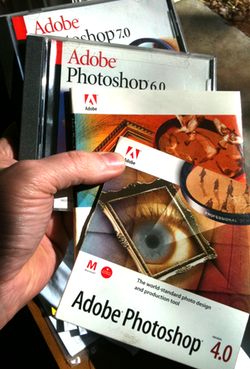Converged, 20 years on.
Thursday, February 18th, 2010
 Friday, February 19th is the 20th birthday of Photoshop. Yes, the software that liberated me from paint systems that cost six figures is two decades old, and in that staggeringly long time (when you measure in ones and zeroes) has grown from a simple way to make and alter bitmapped images to a complex, multilayered, largely 3d and multiframed behemoth that has all kinds of horsepower to handle massively megapixel-y frames of stuff in lots of different formats.
Friday, February 19th is the 20th birthday of Photoshop. Yes, the software that liberated me from paint systems that cost six figures is two decades old, and in that staggeringly long time (when you measure in ones and zeroes) has grown from a simple way to make and alter bitmapped images to a complex, multilayered, largely 3d and multiframed behemoth that has all kinds of horsepower to handle massively megapixel-y frames of stuff in lots of different formats.
It also, increasingly, has the tools to help ordinary joes create retouched reality that is nearly undetectable except by those who examine their work on a fractal/pixel level.
I spoke at a SMPTE conference 20 years ago about how to use the tools of the time to work with multigenerational video to create layers of graphic design (back in a time where television’s on-air look was distinguished by a distinct lack of layering. The demo I showed used the state-of-the-then-art, a $160,000 Quantel Paintbox, to create text, color gradients, and the raw material that I would layer into multigenerational creations. And this was a device that could only work at the (amazingly low) resolution of standard definition (ah, we used to call it NTSC) television.
A month later—a month later—Photoshop was released. And yes, that changed everything.
So in 1993, I gave a talk to a bunch of NBC promo execs (back when they could have deluxe retreats and talks) about everything having been changed, and I, well, kinda geeked out about the possibilties of working with desktop systems and this cool program called Photoshop and vector files and a new compositing program called COSA After Effects. I went on at some length, and in a terrifying amount of detail, as I’ve been known to do, and, well, I suspect I baffled more than enlightened my audience, but now here we are.
Everyone knows the word Photoshop, and most use it as a generic to mean “mess with an image.” There are websites that celebrate and call out the overuse and misuse of the venerable application’s powers. There are songs—not very good ones, or I’d link to them—venerating and trashing the app.
So thanks, Knoll brothers and Adobe, for extending what was only the work of a few specialists now into the grasp of nearly anyone with a laptop in a coffeehouse. And as we sit here in the ‘now’ where fancy tablet computing thingies are about to ship that may well open up even newer digital highways for those who find computers way too computer-y and spell the sunset of some of the desktop machines we’ve delighted in for two decades, I’ll still, I suspect, be firing up the venerable program most mornings to design cool things. Or scribble, as I search for an idea.
Oh, and if you (uh, as I do) like to see computer guys who were young punks when they invented the thing get together decades later to reminisce, please enjoy John and Thomas Knoll, Russell Brown, and Steve Guttman sitting around talking.

